Art & Exhibitions
From Rising-Star Painters to the Return of Post-Internet Art—Here’s What’s Stealing the Spotlight at Gallery Weekend Berlin
Berlin Gallery Weekend is open across the city through April 30.
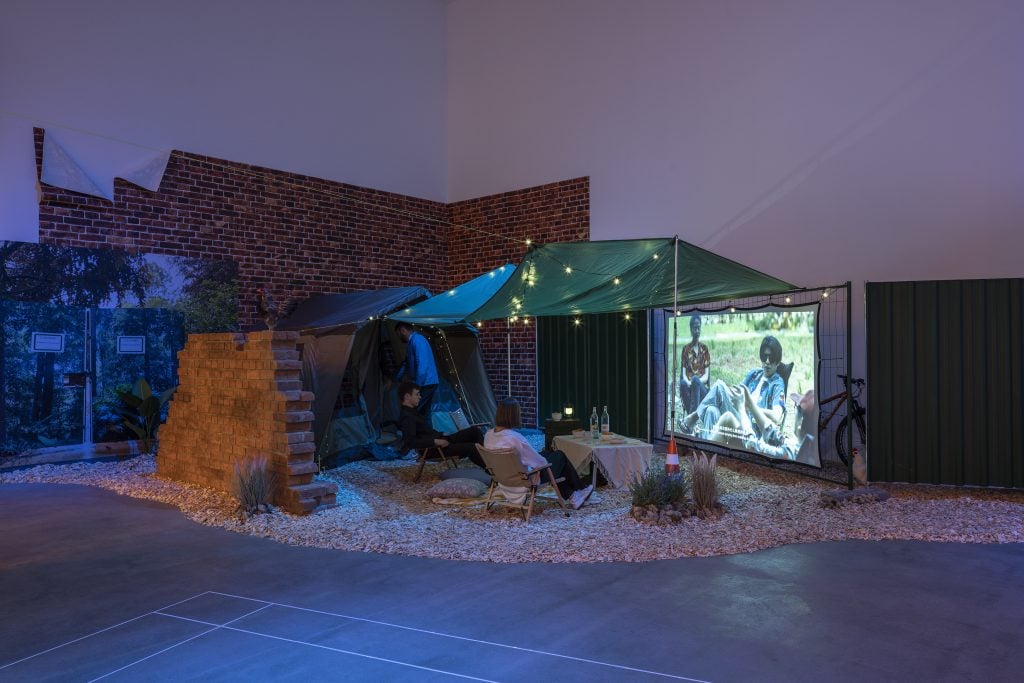
Berlin Gallery Weekend is open across the city through April 30.

Kate Brown

As collectors and curators ritualistically shuffled around Berlin, donning Moncler jackets during this unseasonably cold week in April, the mood of the annual Gallery Weekend Berlin felt, in any case, bright.
Spring is certainly here, and, in terms of the Berlin art world, it felt in some ways like the first real spring in years: after several seasons of largely locally attended editions due to the pandemic, Gallery Weekend now, is officially back on its feet. As such, many out-of-towners were spotted perusing the city’s 50 participant galleries, including collector Uli Sigg, Folakunle Oshun from the Lagos Biennial, Castello di Rivoli Museo d’Arte Contemporanea’s Marcella Beccaria, and Hiuwai Chu from MACBA, as well as Cusson Cheng, Para-site Hong Kong.
In the time between normal editions of the art event, Berlin has evolved, too. A new social energy pulses as four of its major institutions welcome new directors. This week, Klaus Biesenbach was touring the preview on April 27, affectionately documenting artists and dealers on his Instagram at various participating galleries. At Gropius Bau, Performance Space’s Jenny Schlenzka will be arriving this summer to take over the reigns from Stephanie Rosenthal; at Haus der Kulturen der Welt, Bonaventure Soh Bejeng Ndikung is preparing for his official program unveiling in early June. Tomorrow, April 29, at the Hamburger Bahnhof, new directors Sam Bardaouil und Till Fellrath will host the annual Gallery Weekend dinner, attended by the nearly 50 participating galleries and scores of their invited VIPs.
The apparent influx has radiated back on the galleries, which have been perhaps Berlin’s most consistently strong suit over the years. Artnet News tied together a loose grouping three core themes that are worth exploring at this year’s Gallery Weekend Berlin, which opens today, April 28.
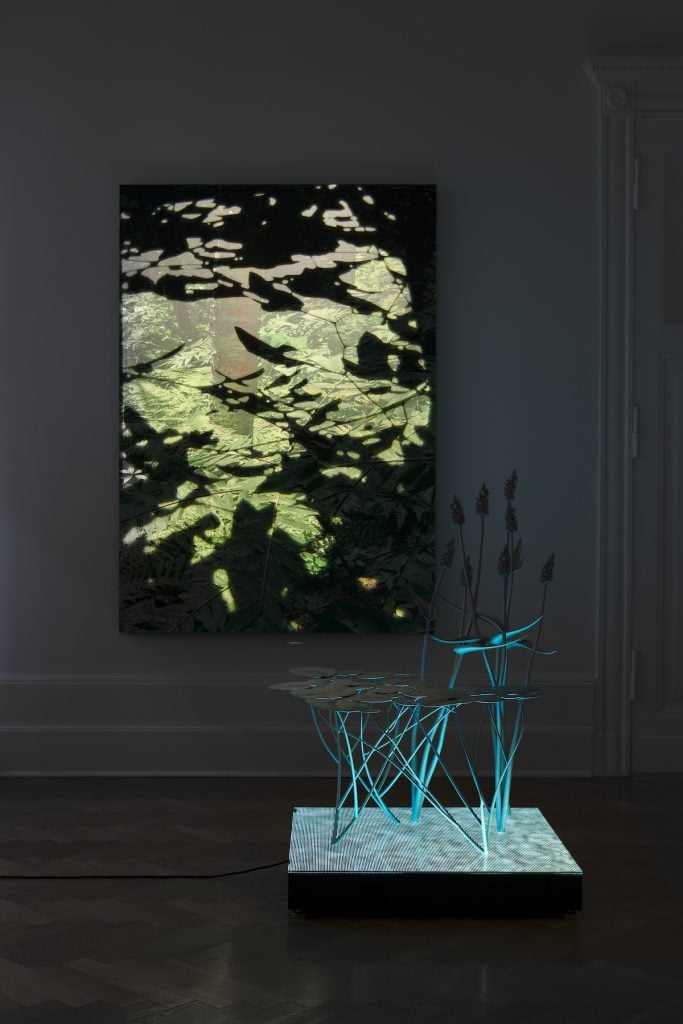
Timur Si-Qin, Untitled (2023) (sculpture) and Untitled (natural origin, 1) (2023) (wall work). Courtesy the artist and Société, Berlin.
One could argue if it really went anywhere at all, but, at least in Berlin—an incubator of the post-Internet art aesthetic that peaked during the 2016 DIS-curated Berlin Biennale—there was a small but noted hiatus. In due course, many of the artists associated with the scene have had celebratory comebacks; last fall, during the annual Berlin Art Week in September, Jon Rafman opened a pair of major exhibitions at Sprüth Magers and the art institution Schinkel Pavilion; at Galerie Isabella Bortolozzi, video artist Ed Atkins returned to town as well. Given the city’s own history with the the aesthetics and discourse, artists working at this cusp of technology find an engaged and well-versed audience. For Berlin Gallery Weekend this year, the welcome home party continues with artists who intersect with that cohort.
At Société, New York-based artist Timur Si-Qin (who presented at the 2016 Berlin Biennale) has transformed the gallery into a darkened and serene semblance of a greenhouse using technologically-embedded nature, culled from memories and field notes of physical locations the artist has visited. He folds these disparate geographic sites together here into one all-encompassing environment for his exhibition “Natural Origin.” At Galerie Neu, through a new array of cozy sculptures, Olso-based Ynge Holen explores the contentious 5G networks which have already deeply infiltrated society and the landscape. Across town at Wentrup, German artist Britta Thie brings together a series of paintings depicting the backdrops behind the camera of the cinema industry, including solemn and sentimental portraits of the mechanical hardware—lighting, cameras, and other gear—that quietly drive, document, and populate film sets.
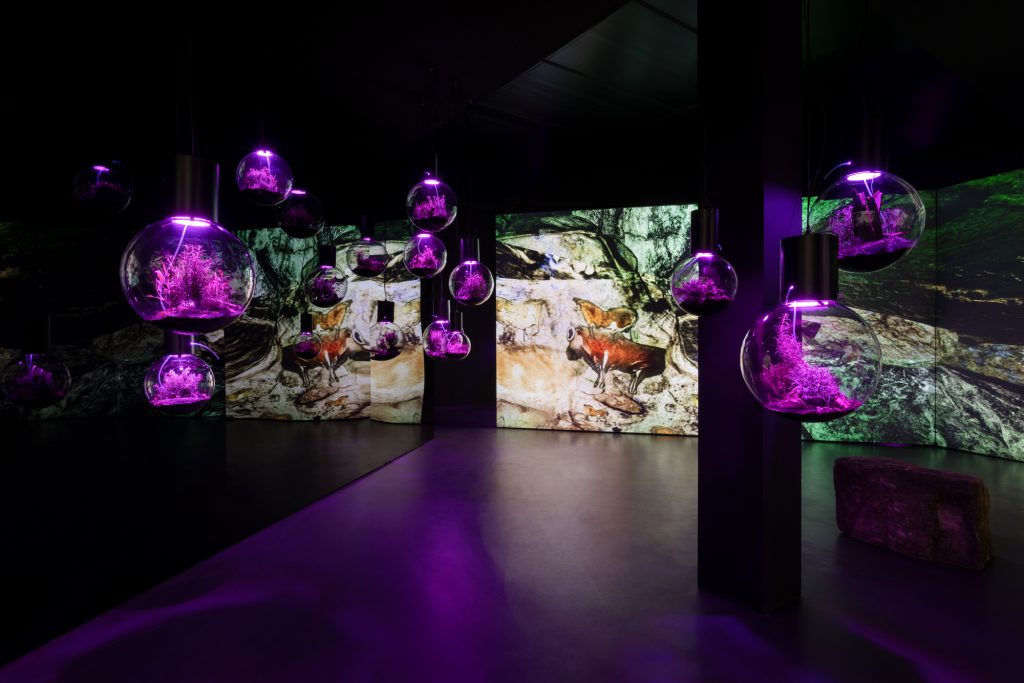
Exhibition view: Hito Steyerl, “Contemporary Cave Art, Esther Schipper, Berlin, 2023. Courtesy the artist, Andrew Kreps Gallery, New York, and Esther Schipper, Berlin/Paris/Seoul © The artist / VG Bild-Kunst, Bonn 2023. Photo © Andrea Rossetti
If you did not get a chance to see Hito Steyerl‘s presentation at Documenta 15 before the work was pulled from the show, it has been given a more expansive second life at Galerie Esther Schipper, in Steyerl’s first exhibition with the gallery. The debut does not disappoint. Her video Animal Spirits is paired again with a reworked and more immersive and impactful version of Contemporary Cave Art at Esther Schipper; interspersed between are a series of 32 illuminated glass spheres with living plants. Each is being sold (for between €1,700 and €2,000) and 100 percent of the raised funds are going to earthquake relief efforts in Turkey and northern Syria.
The post-human investigations take a more playful turn with Chinese artist Cao Fei’s “Duotopia,” a prolific array of video-installations in a museum-style presentation at Sprüth Magers. Across two floors of the gallery, Cao draws a careful balance between optimism and dystopian views about the contemporary world, through her unique blend of science fiction and documentary. She investigates the liminal space between the metaversal and physical realities, the fluid alter-egos of avatars, and geopolitical boundary between Russia and the artist’s native China, itself a nearly surrealistic site. Each video is considerately sited in rather comfy installations.
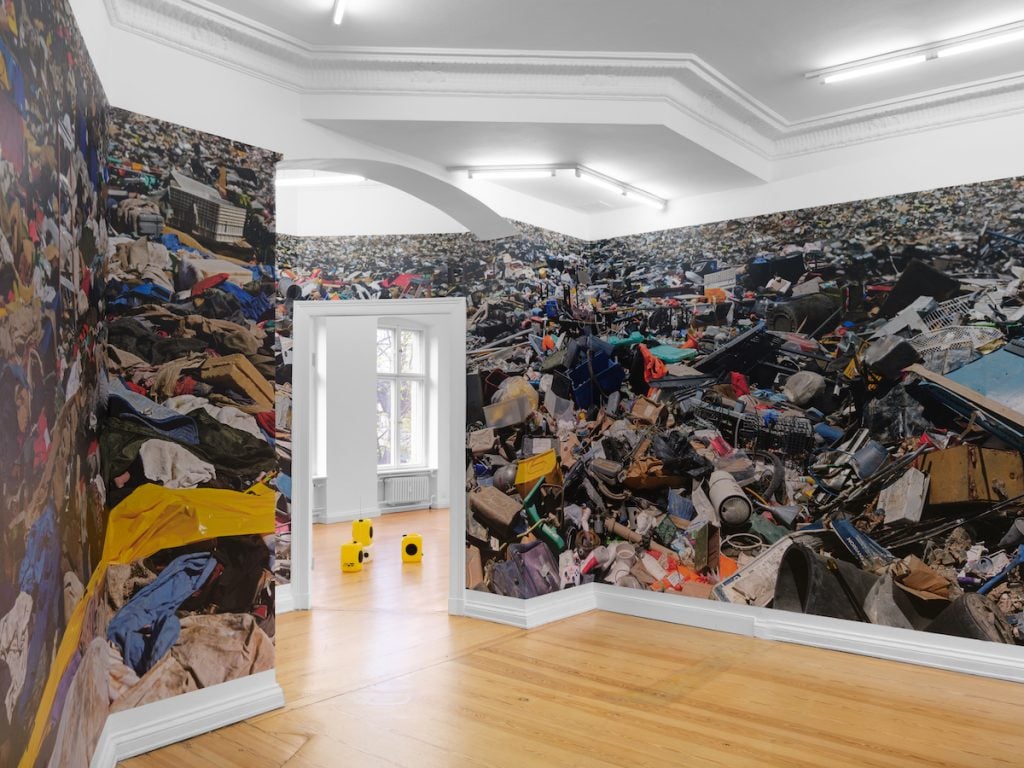
Installation view, Aziz Hazara, “No Dress Code,” 2023. PSM, Berlin. Courtesy of the artist, PSM and Experimenter. Photo: Marjorie Brunet Plaza.
Considered explorations into political issues and how they intersect with the personal narratives appear at several incisive geographic junctures. When walking up to Galerie PSM, a poignant soundscape by Kabul- and Ghent-based Aziz Hazara is already flooding the resplendent hall and staircase. Once inside the gallery, Hazara’s installation environment overwhelms the senses with its sound and imagery, surveying the vast array of object detritus that is left behind by global military operations and Afghanistan in particular. Through trash and trivial objects, this negative space tells the painful story of bodies and war.
ChertLüdde‘s new white cube, multi-room location, which the gallery expanded to last year, finally feels like a space suited to its robust program. On view in the first gallery is Monia Ben Hamouda‘s large installation that takes the form of Islamic calligraphy but, in a transgressive turn against the absence of icons in Islam, verges on the figurative with instances of hand gestures that carefully emerge from the lyrical metal line work of the sculpture, which has been dusted by a variety of Middle Eastern spices.
At Galerie Crone‘s “Simurgh. Ten Female Artists from Iran,” 10 diverse artistic positions from Iranian women are on view. While the show indirectly addresses the ongoing struggle for women’s rights in the country, it does so with a subtle and not overly didactic hand, searching instead for an intergenerational view into Iranian identities and heritage. Described by the Turkish-born, Vienna-based curator Başak Şenova as a “modest gesture of solidarity,” the show begins with a questioning around representations of nationhood, with Anahita Razmi’s spatial installation No National Flag Uses a Gradient #1 – #8 that instead considers the ambiguity of identity. Also on view is an eery video work by Yalda Afsah, showing several people standing outside gazing skyward with an unclear sense of anticipation; the promising filmmaker is the inaugural resident of Wolfgang Tillman’s Between Bridges Residency exhibition, where she is also presenting work.
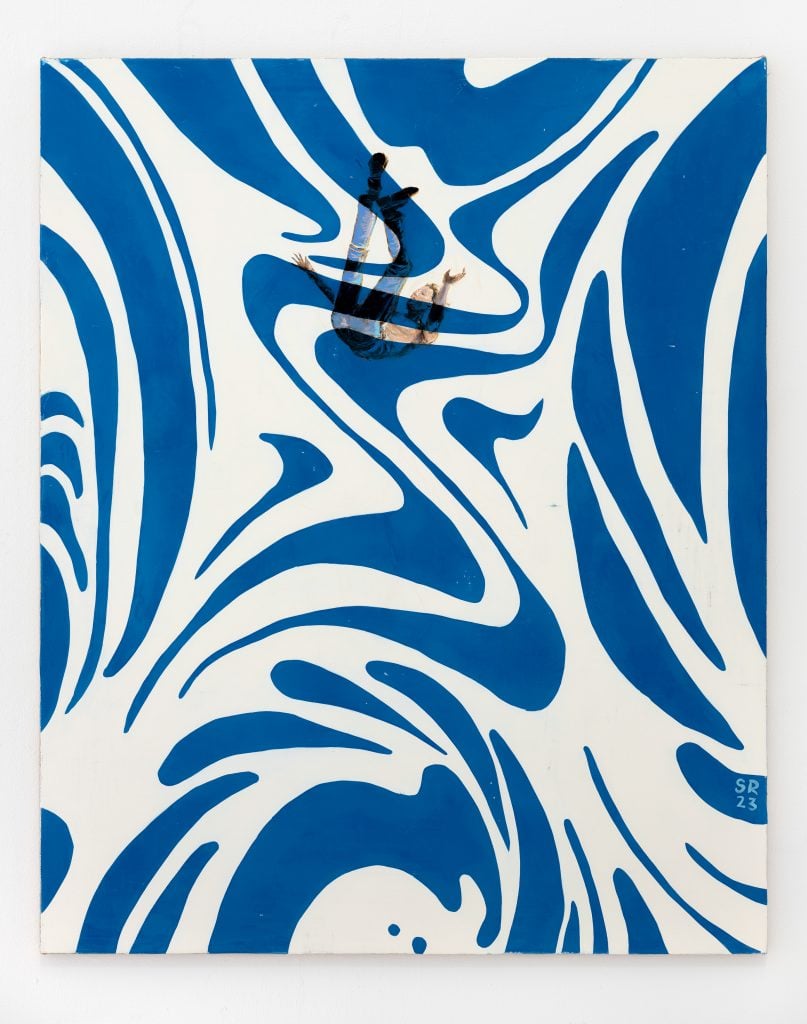
Sophie Reinhold, Ikarus will survive (2023). Photo: Gerhard Kassner. Courtesy the artist and Galerie Nordenhake, Berlin, Stockholm, Mexico City
Equally as adventurous is a tour through the exhibitions of several painterly ascendant stars on view around the city. At Galerie Barbara Weiss, Mexican artist Frieda Toranzo Jaeger plays with form and scale in her paintings that verge towards the sculptural, empowering craft processes and folklore references by tying them together with the sleek contemporary vessel of the automobile, a recurring theme in her paintings. Toranzo Jaeger deconstructs its symbolism as a status of power.
For her first solo exhibition with Nordenhake, the German painter Sophie Reinhold unfurls her fascinatingly versatile visual language that is consistently threaded by an incisive witticism. On view are surreal and seemingly effortlessly stylish canvases that also borrow some Pop art sensibility, like the blue marbling that overlays a small figure in Ikarus will survive. Rheinhold’s somnambulic images are offset in the gallery by a sharp sculptural intervention cutting through the space.
Also rather dreamy are the blue-hued canvases by Dylan Solomon Kraus that explore the symbolism hiding across celestial and earthly landscapes at Peres Projects, and delicately verge on the abstract.
In another gallery debut, for his first show with Galerie Buccholz, Samuel Hindolo, who received a nod from critic Hilton Als in the New Yorker last fall for his exhibition at 15 Orient, presents nearly a dozen meticulous and unsettling paintings. The potent effect of Hindolo’s strangely mixed scenes and perspectives is oneiric, and as Als said, a reminder that “a canvas doesn’t have to make literal sense to be successful—it has only to abide by its own painting rules.”
Berlin Gallery Weekend is opening across the city from April 28 through April 30.
